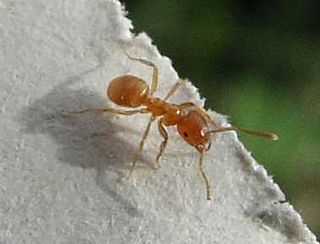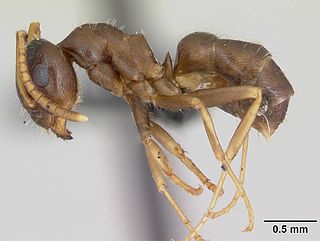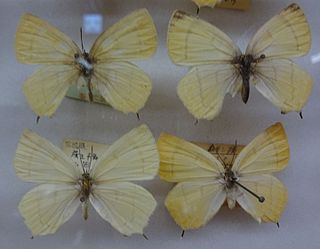
Lasius is a genus of formicine ants. The type species for this genus is the black garden ant, Lasius niger. Other major members, which live in drier heathland, are the cornfield ant, L. neoniger, and L. alienus. Other species include the temporary social parasites of the L. mixtus group and the hyper-social parasite Lasius fuliginosus. Lasius flavus is also a commonly seen species, building grassy hillocks in undisturbed pasture. In the Alps, these mounds - always aligned east to catch the first rays of the rising sun - have been traditionally used by goatherds as natural compasses. Species in the subgenus Acanthomyops, in particular L. interjectus and L. claviger, are commonly known as citronella ants due to their citronella-like smell.

Fire ants are several species of ants in the genus Solenopsis, which includes over 200 species. Solenopsis are stinging ants, and most of their common names reflect this, for example, ginger ants and tropical fire ants. Many of the names shared by this genus are often used interchangeably to refer to other species of ant, such as the term red ant, mostly because of their similar coloration despite not being in the genus Solenopsis. Both Myrmica rubra and Pogonomyrmex barbatus are common examples of non-Solenopsis ants being termed red ants.

The black garden ant, also known as the common black ant, is a formicine ant, the type species of the subgenus Lasius, which is found across Europe and in some parts of North America, South America, Asia and Australasia. The European species was split into two species; L. niger, which are found in open areas; and L. platythorax, which is found in forest habitats. It is monogynous, meaning colonies contain a single queen.

Acteonidae, common name the "barrel bubble snails", is a family of small sea snails, marine gastropod mollusks of the informal group Lower Heterobranchia.

The Phoridae are a family of small, hump-backed flies resembling fruit flies. Phorid flies can often be identified by their escape habit of running rapidly across a surface rather than taking to the wing. This behaviour is a source of one of their alternate names, scuttle fly. Another vernacular name, coffin fly, refers to Conicera tibialis. About 4,000 species are known in 230 genera. The most well-known species is cosmopolitan Megaselia scalaris. At 0.4 mm in length, the world's smallest fly is the phorid Euryplatea nanaknihali.

The yellow meadow ant, also known as the yellow hill ant, is a species of ant occurring in Europe, Asia, and North Africa. Populations in North America are now considered a different, related species, Lasius brevicornis.

Lasius neglectus is a polygynous, sometimes invasive, ant of the genus Lasius. The ant was identified in 1990 after establishing a colony in Budapest, Hungary. Superficially, they are similar in appearance to the common black garden ant, Lasius niger, but have significantly different behavioural patterns, particularly in the social structure within colonies.

Lasius umbratus, colloquially known as the yellow shadow ant and yellow lawn ant, is a palearctic species of parasitic ant distributed across Eurasia and the Maghreb region of Africa. It was once thought that this species occurred in North America as well, but comparative genomic studies indicate the Afro-Eurasian and American populations are discrete and not closely related enough to represent a single species. The North American populations are now treated as a different species, Lasius aphidicola.
Neomedina is a genus of parasitic flies in the family Tachinidae.

The Metopininae are a subfamily of flies in the family Phoridae.

Shirozua jonasi, the orange hairstreak, is a butterfly of the subfamily Lycaeninae. It was described by Edward Wesley Janson in 1877. It is found in the Russian Far East, north-eastern China, Korea and Japan. It is widely distributed in the forest belt.
Myriophora alexandrae is a parasitic insect from the genus Myriophora. Myriophora are flies that kill their definitive host, millipedes.

Pseudacteon is a genus of flies in the family Phoridae. There are over 70 described species of Pseudacteon fly. They are also known as ant-decapitating flies due to their parasitic larval stage. An egg is injected by the female fly into the shoulder joint of an ant worker. Soon after, the egg undergoes rapid inflation as it appears to absorb ant hemolymph. This first instar larva migrates into the ant head and consumes the jaw muscle and other tissues, leaving the mandibles hanging and preparing a future exit space. After about two weeks, the ant worker is termed a "zombie" because the fly larva has effectively taken control. The worker leaves the nest and dies in the leaf litter or in a crack in the soil. As it dies, the ant's head falls off, apparently because the fly larva releases an enzyme that dissolves the membrane attaching the ant's head to its body. The fly pupates in the detached head capsule, requiring a further two weeks before emerging through the ant's mouth. In tropical, subtropical areas the flies are active all year round, but in temperate regions they are active during all months except the winter months. Several Pseudacteon species were deliberately introduced to the United States to combat via biological control the invasive fire ant species Solenopsis invicta.

Xenomorphia is an extinct genus of parasitoid wasp comprising two species: X. resurrecta and X. handschini. The generic name is in reference to the parasitic Xenomorph creature starring in the Alien franchise. The wasp's first fossils were discovered in Oligocene (Chattian) aged phosphorite mines located in the former Quercy province of France, the remains of 55 ancient fly (Phoridae) pupae were found preserved with Xenomorphia wasps inside of them, recording a parasitic relationship between the two insects. Along with the two Xenomorphia wasp species, two other new wasp taxa were identified, Coptera anka, and Palaeortonaquercyensis.
Pseudacteon tricuspis is a parasitic phorid fly that decapitates its host, the imported Solenopsis invicta fire ant. There are over 70 described species within the Pseudacteon genus, which parasitize a variety of ant species. However, P. tricuspis is very specific to its host ant and will not attack other native ant species, making it a good biological control against the fire ant. P. tricuspis was also introduced into the United States for this purpose. Aside from the United States, P. tricuspis has also been found in South America, Europe, and Asia. Female P. tricuspis deposit their eggs directly into the fire ant host. Deposition into the ant host determines the sex of the egg, which grows within the host until adulthood, killing and decapitating the host in the process. Interestingly, P. tricuspis has a male-biased sex ratio, where the males are smaller than the females.

The Metopininae is a tribe of flies in the family Phoridae.
Commoptera is a genus of flies in the family Phoridae.

Aenigmatias is a genus of flies in the family Phoridae.
Myriophora is a genus of flies in the family Phoridae.











